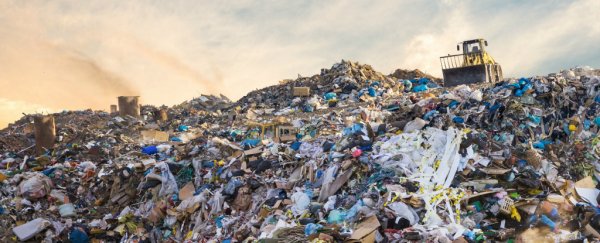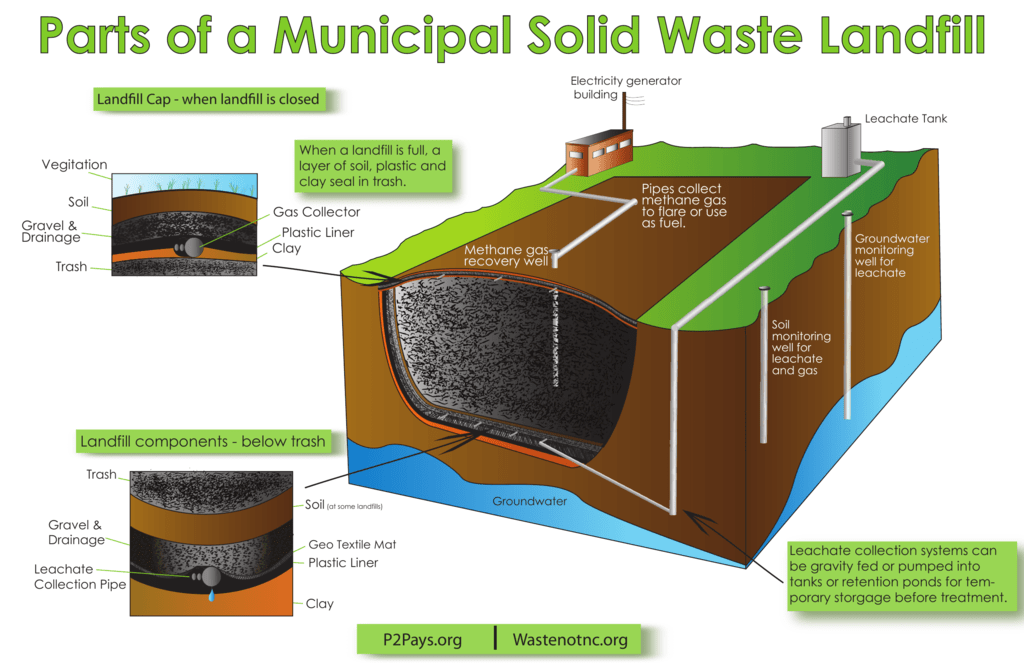
Image source: https://www.openaccessgovernment.org/what-are-the-alternatives-to-landfill/53719/
History
Landfills are a relatively recent development in the context of the history of humanity, but so is the enormous amount of waste that we produce in modern society. Prior to the 20th century, most people would simply throw their waste out of their windows. As garbage began piling up in populated areas, cities began to look for ways to control this trash issue [1]. In 1935, the first landfill-resembling solution was implemented in California, although it was still much different than landfills today [1]. Early landfills were simple open dump grounds, where gas and chemicals could easily escape into the air, soil, and groundwater [1]. An example landfill from the 50s in California consisted of trash spread out over a large area with easy access for scavengers. Additionally, pigs were allowed to feed on the refuse overnight. After the scavengers and pigs had time to thin the pile, the trash was burned. There were so many environmental and sanitary issues with these forms of landfills, most notably the air pollution from incineration, the lack of sanitation of the pigs, and the leaching of pollutants into the local environment [2].
How They Work

Image source: https://www.dumpsters.com/blog/how-do-modern-landfills-work
The modern landfill is much more sanitary and focuses more on protecting the environment from the dangerous substances that can be found in landfills. Landfills are initially holes dug into the ground, with the bottom being lined with dense clay and high-density plastic sheets to prevent leachate – liquid from a landfill containing contaminants such as volatile organic compounds, chloride, nitrogen, solvents, phenols, and heavy metals – from escaping into the soil below [1]. Pipes are installed to instead collect the leachate and take it to a treatment site [1]. Additionally, gas extraction wells are common in modern day landfills to collect the methane produced by decomposing organic material [1]. This methane is typically treated and then used to create electricity. Each day, compacted trash arrives at the site and is placed in a cell, which is a volume of varying size that is covered with a layer of tarps and soil [1]. Once a cell is full, it is sealed, and a new cell is begun. When the landfill is finally full of cells, it is capped, with additional clay and plastic liners on the top and then 2 feet of soil, grass, and vegetation [1].
Regulation
Landfills in the United States are regulated by the Environmental Protection Agency (EPA), with the Resource Conservation and Recovery Act (RCRA) being the primary law guiding the proper management of both non- hazardous and hazardous solid waste [3]. Signed into law in 1976, the RCRA’s Subtitle D regulates both Municipal Solid Waste Landfills (MSWLFs), which receive household waste and some industrial waste, and Industrial Waste Landfills, which collect commercial and industrial waste [4]. Separate landfills also exist to deal with hazardous waste, which fall under Subtitle C of the RCRA [4].
Subtitle D contains regulations that govern landfill design, location, corrective action, and closure, and has been amended multiple times since 1976 [5]. States play a crucial role in ensuring that these federal regulations are met, and may also impose additional restrictions, leading to a varying performance of waste management among states [6]. Location restrictions under this subtitle involve and consider nearby airports, floodplains, wetlands, and seismic activity zones [7]. Operation procedures are put in place for factors such as water run-off, air quality, disease vectors, and surface water [7]. Other critical aspects of Subtitle D are the requirements for the liners of new MSWLF units, the closure of landfill systems, and groundwater monitoring [7].
Future Outlook

Image source: https://www.fastcompany.com/3062853/these-maps-show-how-much-of-the-us-is-covered-in-landfills
The United States has 2,000 active landfills, as each American throws out an average of 4.4 pounds of trash a day [8]. Some reports claim that the US is on track to run out of room in landfills in the next 18 years, which would create an environmental disaster [9]. This is primarily an issue in the Northeast, and is worsened by the fact that the amount of solid waste being produced continues to rise [9]. To address this issue, more landfills may need to be created, which takes time and money and is unpopular with almost any community due to the pollution produced by the sites. The best option environmentally and financially would be to stop producing as much trash in the first place. Other options include burning trash. Currently, the US burns 33 million tons of waste each year for energy [9]. Other countries such as Sweden burn up to half of their solid waste and implement methods to reduce the emissions and air pollution from the burning [9].
The current state of landfills is far from perfect as well. Despite the improving sanitary methods of modern day landfill construction, every landfill negatively affects its surroundings. Even the EPA has claimed, “No liner… can keep all liquids out of the ground for all time. Eventually liners will either degrade, tear, or crack and will allow liquid to migrate out of the unit” [10]. Additionally, older landfills cannot be retrofitted with new technology, and closed landfills especially pose a threat to the environment. All experts in the field point to the prevention of producing so much waste as the only true was to tackle the issues posed by landfills [2].
[1] “Do You Know the Difference Between a Landfill and a Dump?,” Learn How Modern Landfills Work | Dumpsters.com. [Online]. Available: https://www.dumpsters.com/blog/how-do-modern-landfills-work. [Accessed: 8-Feb-2020].
[2] StackPath. [Online]. Available: https://www.mswmanagement.com/landfills/article/13025970/a-brief-history-of-solid-waste-mangement-in-the-us-during-the-last-50-years-part-2. [Accessed: 8-Feb-2020].
[3] “Resource Conservation and Recovery Act (RCRA) Laws and Regulations,” EPA, 14-Jan-2020. [Online]. Available: https://www.epa.gov/rcra. [Accessed: 10-Feb-2020].
[4] “Basic Information about Landfills,” EPA, 03-Apr-2019. [Online]. Available: https://www.epa.gov/landfills/basic-information-about-landfills#whatis. [Accessed: 7-Feb-2020].
[5] “Resource Conservation and Recovery Act (RCRA) Overview,” EPA, 12-Nov-2019. [Online]. Available: https://www.epa.gov/rcra/resource-conservation-and-recovery-act-rcra-overview. [Accessed: 13-Feb-2020].
[6] “Municipal Solid Waste Landfills,” EPA, 13-Sep-2018. [Online]. Available: https://www.epa.gov/landfills/municipal-solid-waste-landfills. [Accessed: 13-Feb-2020].
[7] “RCRA-Subtitle-D-Regulations1,” Land Techna, 2014. [Online]. Available: http://www.landtecna.com/wp-content/uploads/2014/12/RCRA-Subtitle-D-Regulations1.pdf. [Accessed: 11-Feb-2020].
[8] A. Peters, “These Maps Show How Many Landfills There Are In The U.S.,” Fast Company, 19-Aug-2016. [Online]. Available: https://www.fastcompany.com/3062853/these-maps-show-how-much-of-the-us-is-covered-in-landfills. [Accessed: 11-Feb-2020].
[9] “Where Will The Trash Go When All the US Landfills Are Full?,” Global Citizen. [Online]. Available: https://www.globalcitizen.org/en/content/us-landfills-are-filling-up/. [Accessed: 8-Feb-2020].
[10] “MGWC,” EPA, Aug-2015. [Online]. Available: https://www.epa.gov/sites/production/files/2015-08/documents/mgwc-gwc1.pdf. [Accessed: 14-Feb-2020].